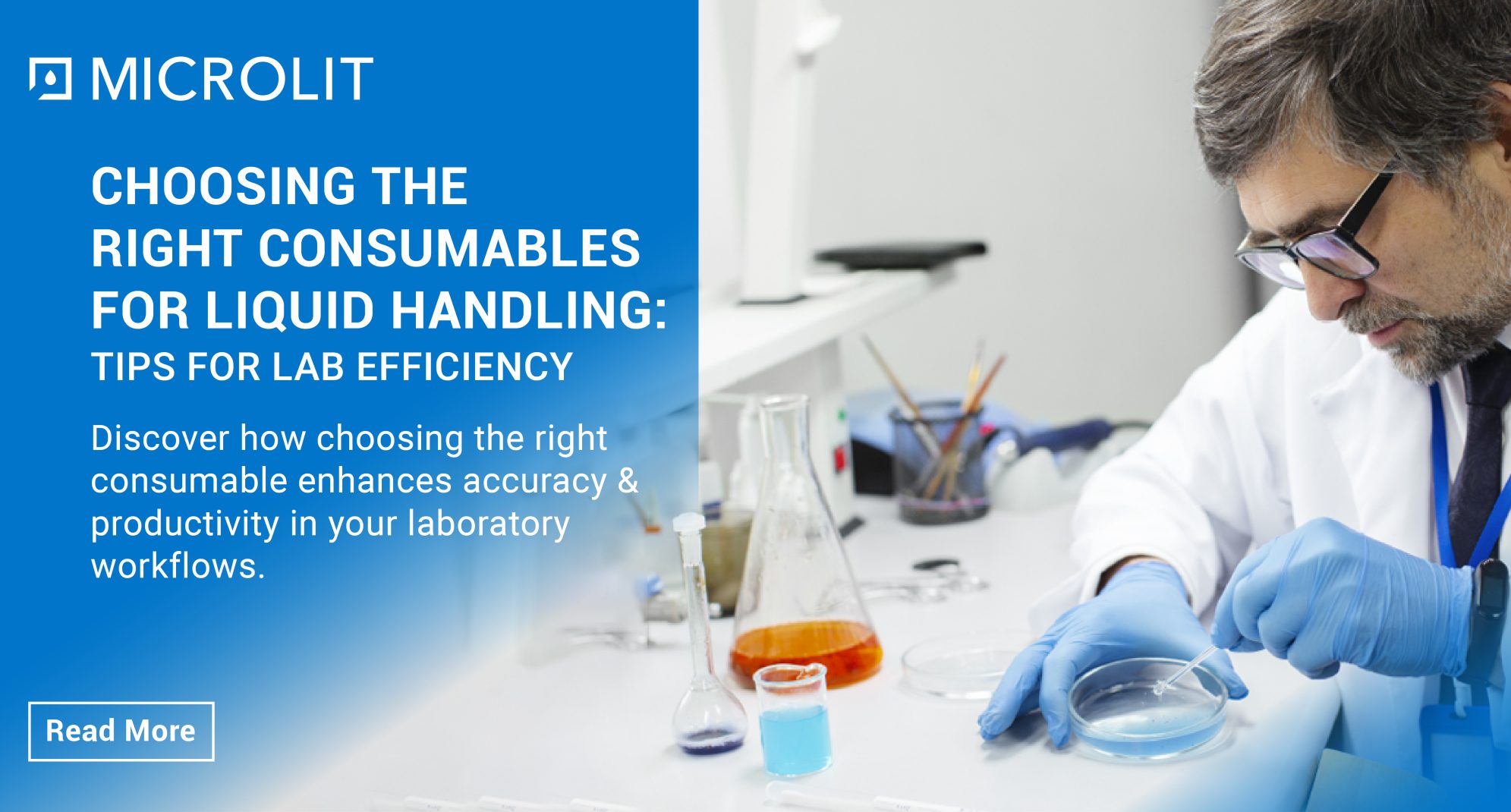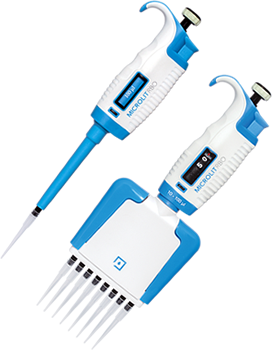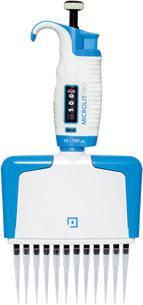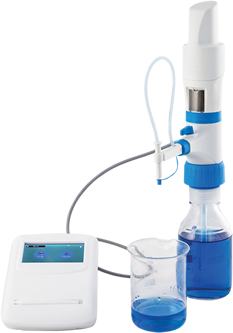Liquid handling is a critical component of laboratory work, encompassing everything from simple liquid transfers to complex molecular biology experiments. The choice of consumables such as cell culture plates, pipette tips, PCR plates, cryogenic vials, and ELISA plates significantly impacts the accuracy, efficiency, and reliability of lab operations.
Selecting the right consumables not only ensures accurate and reproducible results, but it also improves workflow efficiency and lowers costs. Here are some essential tips for selecting the right liquid handling consumables to boost lab efficiency.
-
Understand Your Application Needs
The first step in choosing the right consumables is to understand your applications’ specific requirements. Different tasks demand varying levels of precision, volume ranges, and chemical compatibility. For example, cell culture requires sterile, biocompatible consumables, whereas molecular biology techniques such as PCR demand high precision and contamination-free materials.
Key Considerations:
- Volume Range:Determine the volume range that you will be handling. Micro-volume applications (less than 1 µL) require specialized tips and plates.
- Precision and Accuracy:High-precision tasks require consumables that reduce variability and error.
- Chemical compatibility:Ensure that the consumables’ materials are compatible with the chemicals and reagents you will be using.
-
Select the right consumable according to your need
The second step, selecting the right consumables according to your application needs, is critical for achieving accurate and reliable results in any laboratory setting. Consumables such as cell culture plates, pipette tips, PCR plates, cryogenic vials, and ELISA plates play pivotal roles in various experiments and analyses. The choice of consumables can significantly impact the precision, efficiency, and overall success of laboratory workflows.
Cell Culture Plates and Flasks
Cell culture and tissue culture are foundational techniques in biology and biomedical research. The consumables used in these applications need to support optimal cell growth and viability.
Types of Cell Culture Consumables:
- Cell Culture Plates:Cell culture plates come in a variety of well sizes (6, 12, 24, 96, and 384 wells) and are used for high-throughput screening, cell-based assays, and routine cell culture.
- Cell Culture Flasks:These are used for growing larger volumes of cells. They come in different sizes and surface treatments to support specific cell types.
Key Considerations:
- Surface Treatment:Choose plates and flasks with surfaces treated to enhance cell attachment and growth, such as tissue-culture-treated surfaces.
- Material:Polystyrene is commonly used for cell culture consumables due to its optical clarity and biocompatibility.
- Sterility:Ensure all cell culture consumables are sterile to prevent contamination.
Tips for Selection:
- Use tissue-culture-treated plates and flasks for adherent cells.
- For suspension cultures, select non-treated or low-adherence surfaces.
- Consider using multi-well plates for high-throughput applications to save time and resources.
Pipette Tips for Liquid Handling
Pipette tips are essential for precise liquid handling in many laboratory applications. The proper pipette tips can significantly improve the accuracy and efficiency of your work.
Types of Pipette Tips:
- Standard Tips:Suitable for general-purpose pipetting.
- Low-Retention Tips:Designed for sticky or viscous substances to minimize sample loss.
- Filter Tips:Prevent aerosol contamination, essential for PCR and other sensitive techniques.
Key Considerations:
- Compatibility:Ensure the pipette tips are compatible with your pipettes to achieve optimal performance.
- Sterility:Use sterile tips for applications requiring contamination control.
- Precision:High-quality tips that provide accurate volume measurements and reproducibility.
Tips for Selection:
- Match pipette and tip brands if possible to ensure compatibility.
- Use low-retention tips for accurate dispensing of viscous liquids.
- Select filter tips for applications requiring contamination control, such as molecular biology and microbiology.
PCR Plates and Tubes for Molecular Biology
Polymerase Chain Reaction (PCR) is a key component of molecular biology. The consumables used in PCR must provide optimal thermal transfer while preventing contamination.
Types of PCR Consumables:
- PCR Plates:Available in 96-well and 384-well formats, these plates are used for high-throughput PCR applications.
- PCR Tubes:Thin-walled tubes designed for individual or small-scale PCR reactions.
Key Considerations:
- Thermal Transfer:Ensure that PCR plates and tubes have thin walls for efficient thermal cycling.
- Sealability:Good sealing is crucial to prevent sample evaporation and contamination.
- Compatibility:Ensure the consumables are compatible with your PCR machine.
Tips for Selection:
- Use white PCR plates for fluorescence-based applications to enhance signal detection.
- Select PCR tubes with snap caps or optical flat caps for qPCR to ensure secure sealing and accurate fluorescence readings.
- Consider using skirted plates for added stability in automated systems.
Cryogenic Boxes and Vials for Storage
Proper storage of biological samples is critical for maintaining their integrity. Cryogenic boxes and vials are designed to withstand extremely low temperatures while maintaining sample viability.
Types of Storage Consumables:
- Cryogenic Vials:Used for storing samples at cryogenic temperatures (-80°C to -196°C).
- Cryogenic Boxes:Provide organized storage and easy identification of cryogenic vials.
Key Considerations:
- Material:Polypropylene is commonly used for cryogenic vials due to its durability and chemical resistance.
- Volume:Choose vials with appropriate volume capacity for your samples.
- Labeling:Ensure easy labeling and identification of vials.
Tips for Selection:
- Use cryogenic vials with external threads to reduce the risk of contamination.
- Store vials in cryogenic boxes with clear labeling for efficient sample retrieval.
- Consider using color-coded vials and boxes to simplify sample organization.
ELISA Plates for Biochemistry
Enzyme-Linked Immunosorbent Assay (ELISA) is a widely used technique in biochemistry for detecting and quantifying substances. The quality of ELISA plates can significantly affect assay sensitivity and accuracy.
Types of ELISA Plates:
- High-Binding Plates:Designed to capture antibodies or antigens efficiently.
- Low-Binding Plates:Used for applications where non-specific binding needs to be minimized.
Key Considerations:
- Well Format:Choose the appropriate well format (96 or 384 wells) based on your throughput needs.
- Material:Polystyrene is commonly used for ELISA plates due to its binding properties and optical clarity.
- Surface Treatment:Select plates with high-binding surfaces for increased sensitivity.
Tips for Selection:
- Use high-binding ELISA plates for detecting low-abundance targets.
- Choose clear plates for colorimetric assays and black or white plates for fluorescence and luminescence assays.
- Ensure the plates are compatible with your plate reader for accurate data collection.
-
Implement Best Practices for Handling and Storage
Proper handling and storage of consumables is critical to their quality and performance. Below are some best practices:
- Use clean gloves when handling consumables to avoid contamination.
- Do not touch the tips or openings of pipette tips and tubes to maintain sterility.
- Store consumables in a clean, dry environment to prevent contamination and degradation.
- Keep them at appropriate temperatures, especially for temperature-sensitive materials like PCR reagents.
- Organize consumables for easy access, reducing the time spent searching for items.
-
Evaluate Cost vs. Quality
While cost is an important consideration, it should not come at the expense of consumable quality and performance. High-quality consumables may be more expensive, but they frequently provide superior accuracy, dependability, and longevity, resulting in overall cost savings.
- Compare products from various suppliers to find the highest quality at a reasonable price.
- Consider bulk purchasing for frequently used consumables to save money.
- Invest in high-quality consumables for critical applications to prevent costly mistakes and rework.
Choosing the right liquid handling consumables is critical for increasing lab efficiency, ensuring accurate results, and protecting the integrity of your experiments. Understanding your application needs, selecting high-quality cell culture plates, pipette tips, PCR plates, cryogenic vials, and ELISA plates, implementing best practices, and staying up to date on technological advances will help you optimize your laboratory’s workflow and achieve more reliable results. Remember that investing in high-quality consumables and proper handling practices can result in significant long-term benefits, including increased productivity and scientific accuracy.
PLASTICUS by Microlit: A New Era of Consumables
Microlit, an established leader in laboratory equipment for over 30 years, is pleased to introduce Plasticus, a comprehensive line of laboratory plasticware consumables designed with the same commitment to quality and innovation that defines our brand.
We identified a critical void in the market for a dependable, reasonably priced, and superior source of lab supplies based on our wealth of knowledge and comprehension of the requirements of scientists and technicians across the globe. The result of this endeavor is Plasticus, which provides a wide array of products that are intended to improve your scientific endeavors.
Every Plasticus product is painstakingly tested, engineered, and created to withstand the demands of even the most demanding research thanks to our strict, multi-step quality protocols. For any inquiry or information related to Plasticus Consumables, please email us at info@plasticus.com or visit our website www.plasticus.com.






 3454
3454





